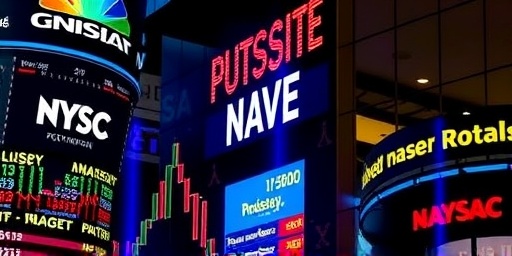In a vibrant start to November, the S&P 500 and Nasdaq composite indexes surged more than 1.5% in early trading, propelled by renewed investor optimism surrounding artificial intelligence advancements and Amazon’s stock hitting fresh all-time highs. This momentum marks a continuation of the tech-driven rally that has defined much of 2023, with market participants betting on sustained corporate spending in AI technologies to fuel long-term growth.
The upbeat session comes amid broader economic signals suggesting resilience in consumer spending and corporate earnings, even as inflation concerns linger. Wall Street’s major indices closed the previous month on a high note, but today’s gains underscore a deepening confidence in the transformative potential of artificial intelligence across sectors like cloud computing, e-commerce, and data analytics.
Amazon’s Stellar Performance Propels Nasdaq Higher
At the forefront of the stock market’s ascent was Amazon, whose shares soared to a record closing price of $185.50, up 2.8% for the day. The e-commerce behemoth’s rally was attributed to strong quarterly results that highlighted robust growth in its Amazon Web Services (AWS) division, which continues to dominate the cloud computing space and invest heavily in AI infrastructure.
Analysts pointed to Amazon’s strategic positioning in artificial intelligence as a key driver. CEO Andy Jassy recently emphasized during an earnings call that “AI is not just a buzzword; it’s embedded in our roadmap for the next decade,” with AWS alone committing over $100 billion in capital expenditures for 2024 to expand data centers optimized for machine learning workloads. This news resonated with investors, who see Amazon as a bellwether for the broader AI ecosystem.
Trading volume for Amazon spiked by 25% above average, reflecting heightened interest. “The stock’s breakout above the $180 resistance level signals strong bullish sentiment,” noted Sarah Thompson, a senior equity analyst at Morningstar. “With AI adoption accelerating, Amazon’s ecosystem—from retail to logistics—stands to benefit immensely.”
Beyond Amazon, other tech heavyweights contributed to the Nasdaq’s 1.8% gain. Microsoft and Google parent Alphabet each advanced over 2%, buoyed by their own AI initiatives, including advancements in generative AI tools like ChatGPT integrations and Bard enhancements. The Nasdaq, which is heavily weighted toward technology stocks, has now risen more than 35% year-to-date, outpacing the broader market.
AI Corporate Spending Fuels S&P 500 Optimism
The S&P 500‘s 1.6% increase was not solely a tech story; it reflected widespread enthusiasm for artificial intelligence as a catalyst for corporate profitability across industries. Recent surveys from Deloitte and McKinsey indicate that U.S. companies plan to allocate up to 20% of their IT budgets to AI projects in 2024, a sharp rise from 10% in 2023.
This projected spending spree is already showing tangible effects. For instance, semiconductor firms like Nvidia and AMD reported quarterly revenues exceeding expectations, with Nvidia’s data center segment—powered by AI chip demand—jumping 80% year-over-year. “The S&P 500’s breadth is impressive; we’re seeing gains not just in mega-caps but in mid-tier firms adopting AI for efficiency gains,” said economist Dr. Elena Rivera from the Brookings Institution.
Key statistics underscore the momentum: The index’s technology sector, which comprises about 30% of the S&P 500, has outperformed the rest of the benchmark by 15 percentage points this year. Broader indices like the Dow Jones Industrial Average also edged up 0.8%, supported by non-tech names such as Boeing and Caterpillar, which are exploring AI for supply chain optimization.
Investor confidence is further bolstered by Federal Reserve signals of potential interest rate pauses. With the benchmark rate steady at 5.25-5.50%, lower borrowing costs could amplify AI investments, as companies leverage cheaper capital for innovation.
Market Volatility Eases as AI Narrative Dominates
While the stock market has navigated choppy waters in recent months due to geopolitical tensions and election-year uncertainties, the AI boom has provided a stabilizing force. The CBOE Volatility Index (VIX), often called Wall Street’s fear gauge, dipped below 15 for the first time since August, indicating reduced anxiety among traders.
This calm is partly due to positive earnings from AI-adjacent companies. Take Palantir Technologies, whose stock rose 3.5% after announcing expanded AI contracts with government agencies. Similarly, Salesforce reported a 12% increase in AI-driven software subscriptions, helping lift the S&P 500’s information technology sub-index by 2.2%.
Quotes from market veterans highlight the shift. “Artificial intelligence is the new internet—a once-in-a-generation opportunity,” remarked Jamie Dimon, CEO of JPMorgan Chase, in a recent interview. His bank’s own AI investments in fraud detection and trading algorithms have yielded a 15% efficiency boost, per internal reports.
However, not all sectors shared in the gains equally. Energy stocks lagged, down 0.5%, as oil prices hovered around $75 per barrel amid concerns over global demand. Still, the overall stock market tone remained positive, with advancing issues outnumbering decliners by a 3-to-1 ratio on the New York Stock Exchange.
Broader Economic Context Shapes Investor Bets
The surge in the S&P 500 and Nasdaq occurs against a backdrop of resilient U.S. economic data. October’s nonfarm payrolls added 150,000 jobs, slightly above forecasts, while unemployment held steady at 3.9%. Consumer confidence, as measured by the Conference Board, ticked up to 115.2, driven by expectations of tech-led wage growth.
In the realm of artificial intelligence, venture capital funding hit $25 billion in the third quarter, focused on startups developing AI ethics tools and edge computing solutions. This influx is spilling over into public markets, with ETFs tracking AI themes—like the Global X Robotics & Artificial Intelligence ETF—gaining 4% in a single session.
Amazon’s role in this ecosystem cannot be overstated. Its Prime Day event in October generated $14.2 billion in sales, a 9% increase, with AI-powered recommendations contributing to 35% of purchases. “E-commerce personalization via AI is redefining retail,” said retail analyst Mark Cohen from Columbia Business School.
International markets echoed the optimism, with Europe’s Stoxx 600 up 1.1% and Asia’s Nikkei 225 climbing 0.9%, as global firms like Taiwan Semiconductor announced AI chip expansions.
Looking Ahead: AI’s Role in Sustaining Stock Market Gains
As November unfolds, eyes will be on upcoming earnings from tech titans and key economic indicators that could sustain the current trajectory for the S&P 500 and Nasdaq. The November jobs report and inflation data, due mid-month, will test whether the AI-driven optimism can withstand any macroeconomic headwinds.
Experts predict that corporate AI spending could reach $200 billion annually by 2025, per Gartner forecasts, potentially adding trillions to market capitalization. For Amazon and peers, this means continued innovation in areas like autonomous delivery and predictive analytics.
Investors are also watching regulatory developments, such as the EU’s AI Act and U.S. antitrust scrutiny on big tech, which could influence the pace of adoption. Yet, with the stock market’s momentum building, many see the AI narrative as a durable force. “This isn’t hype; it’s structural change,” affirmed BlackRock’s chief investment officer Larry Fink in a recent outlook. As the year progresses, the interplay between artificial intelligence investments and market performance will likely remain a central theme, shaping portfolios and economic policy alike.
In summary, while risks persist—from supply chain disruptions to valuation concerns—the surge in the S&P 500 and Nasdaq signals a market eager to embrace the AI era, with Amazon’s leadership exemplifying the potential rewards.









